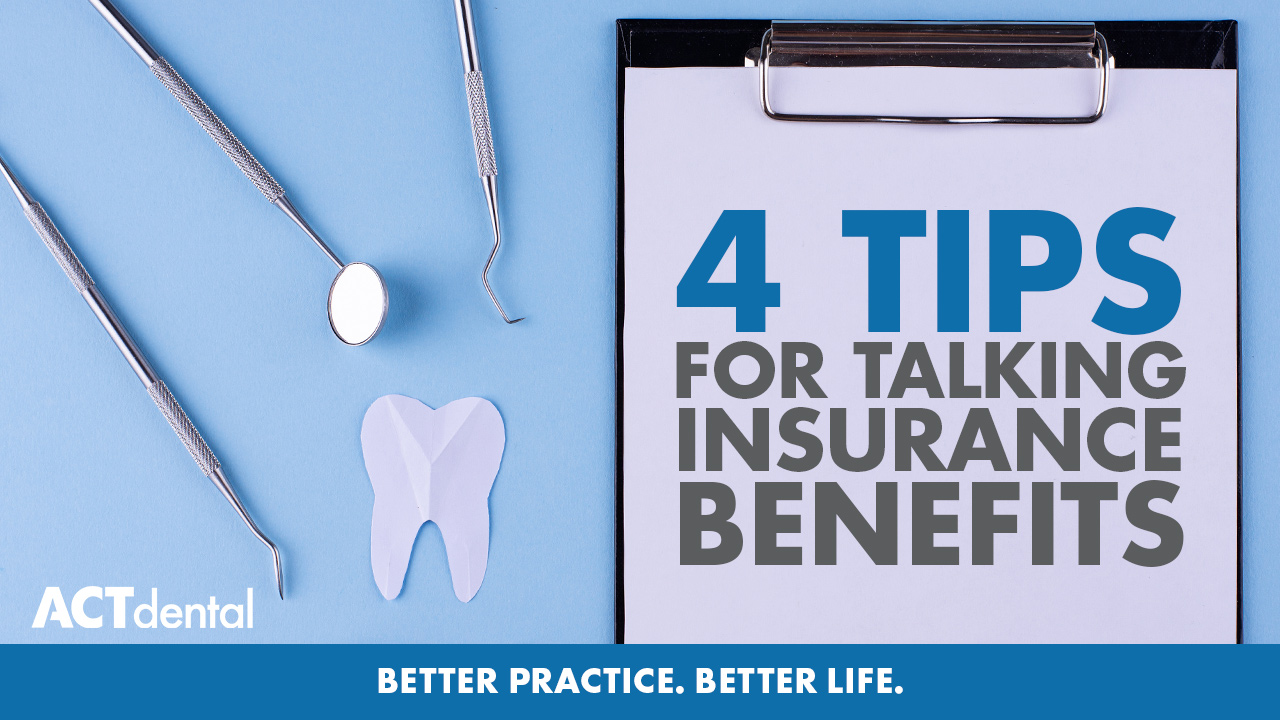Insurance brings a lot of stress with it, and a big part is the anxiety team members feel about talking about it. In fact, answering questions or having discussions around insurance benefits is the leading cause of anxiety for dental team members. It doesn’t have to be that way, though, because with these four tips, you can prepare your team to manage the narrative easily and painlessly, and help your patients understand their options.
- Educate Your Team
The very first step you must take is to educate your team so they understand the general “rules” of insurance, such as:
- The benefits vs. limitations
- In-network vs out-of-network
- What does this mean to the patient?
To make it happen, start setting aside time in your team meetings to review the terminology and rules of dental insurance, making sure to document it so you can use the information when you have to onboard new team members. After all, like Kirk says, “If it’s not in writing, it doesn’t exist!”
- Eliminate “Insurance” from Your Vocabulary
The language we use makes such a difference in how our message is received, and when it comes to insurance, patients are often more familiar with the medical rather than the dental side. However, they’re two different animals, so it’s important that we differentiate between them with our language. I like to use the term “dental benefits” instead of “insurance,” because it lacks any negative connotation that might come from the medical side. You can hammer this difference home by reusing key phrases, such as:
- “Maximizing dental benefits”
- “Understanding your dental plan limitations”
Your words matter, so get your whole team aligned around the correct vocabulary! A great resource for this is ACT’s FREE Say This, Not That tool!
- “Yes” Is Always the Right Answer
If you’re going to provide the insurance-friendly experience that your patients want, then “Yes” is how the conversation should start when asked about insurance:
“Yes, we have many happy patients here with that dental benefits plan. I would love to learn more about you and your dental needs so I can share how we can help maximize your benefits.”
Unlike “No,” it keeps the conversation open, allowing you to explain how their existing dental benefits will work in your practice.
- Make the Patient Your Main Focus
Your patient’s benefit plan should never be your focus, but rather the patient themselves. The best way to do this is by building relationships with them, and then helping those relationships grow and develop as they return to your office. Show interest—genuine interest—in them by paying attention to their:
- Interests
- Concerns
- History
Building a relationship creates trust, and it’s this trust that will result in more treatment. You can still discuss their benefits, but you must be honest and concise, and then drive the conversation back to the patient’s wants and needs.
There are so many nuances in the dental insurance world, and the better you can understand them, the better you can communicate with your patients. With these four tips, your team can overcome their anxiety about insurance, and start helping patients become healthier. Get a free copy of our Tips for Talking Insurance Benefits here, or for more information about ACT and how we can help you build a Better Practice and a Better Life, contact Gina!
Tune in next time and learn how you can master the hand-off and the benefits that come from doing so!
Robyn Theisen
Robyn Theisen brings an entire life and legacy of dental experience to the team and every team with which she works as the daughter and sister of dentists. With almost 20 years of experience in dentistry, her roles ranged from practice management, to Operations at Patterson Dental to coaching teams. Robyn’s passion is empowering teams to realize that they can dramatically impact the lives of the people they serve by implementing skills and systems to remove barriers to life-changing dental treatment. She has done it for decades and does it every day with dental teams. Outside of coaching, she enjoys time with her husband, Rob, and two daughters, Emerson and Ruby. She loves traveling, music, fitness and cheering on the Michigan State Spartans.
RECENT POSTS
990: Hiring the Wrong People? You Might Be Missing This One Crucial Step – Carlie Einarson
January 02, 2026
989: Master the Metrics – Simple Data, Big Impact – Robyn Theisen
December 31, 2025
988: Metric Mondays: Overhead – Facilities and Equipment Percentage – Robyn Theisen
December 29, 2025
987: Core Values Aren't Fluff — They're Your Practice’s Greatest Asset – Heather Crockett
December 26, 2025
986: Security in AI for Your Dental Practice – Travis Wentworth
December 24, 2025
We Lit Up The Year 2025
December 22, 2025
985: Metric Mondays: Overhead – Operations Percentage – Miranda Beeson
December 22, 2025
Evaluate Your Year with Intention
December 19, 2025
984: How to Address Chronic Attendance Issues – Alan Twigg
December 19, 2025
